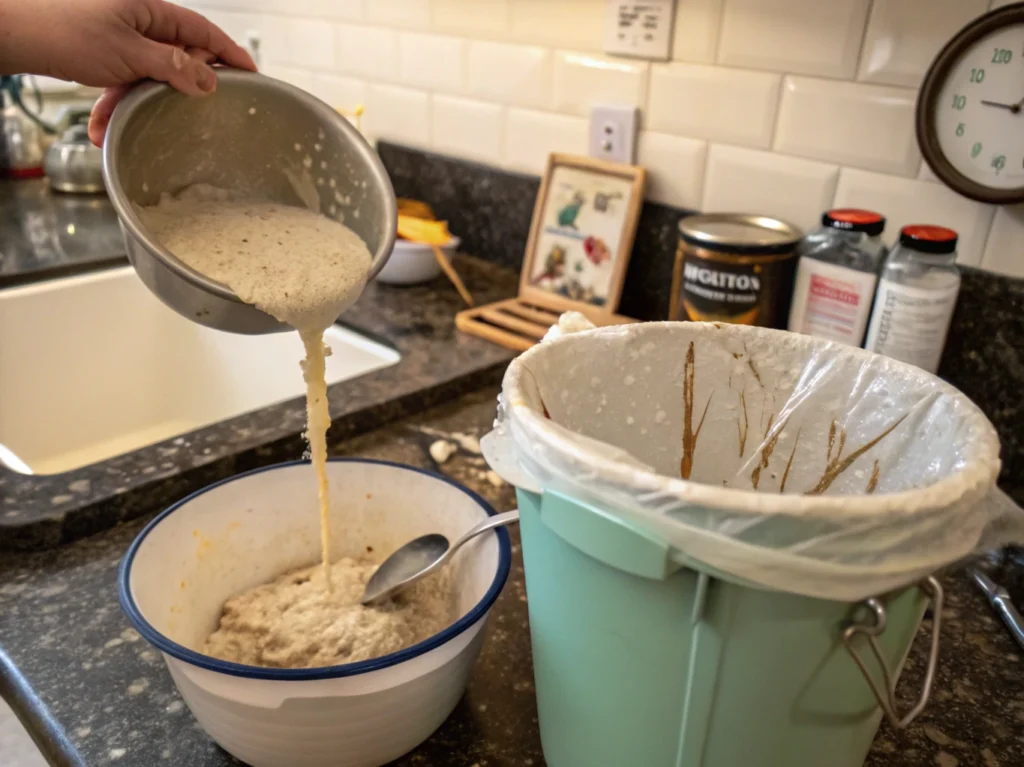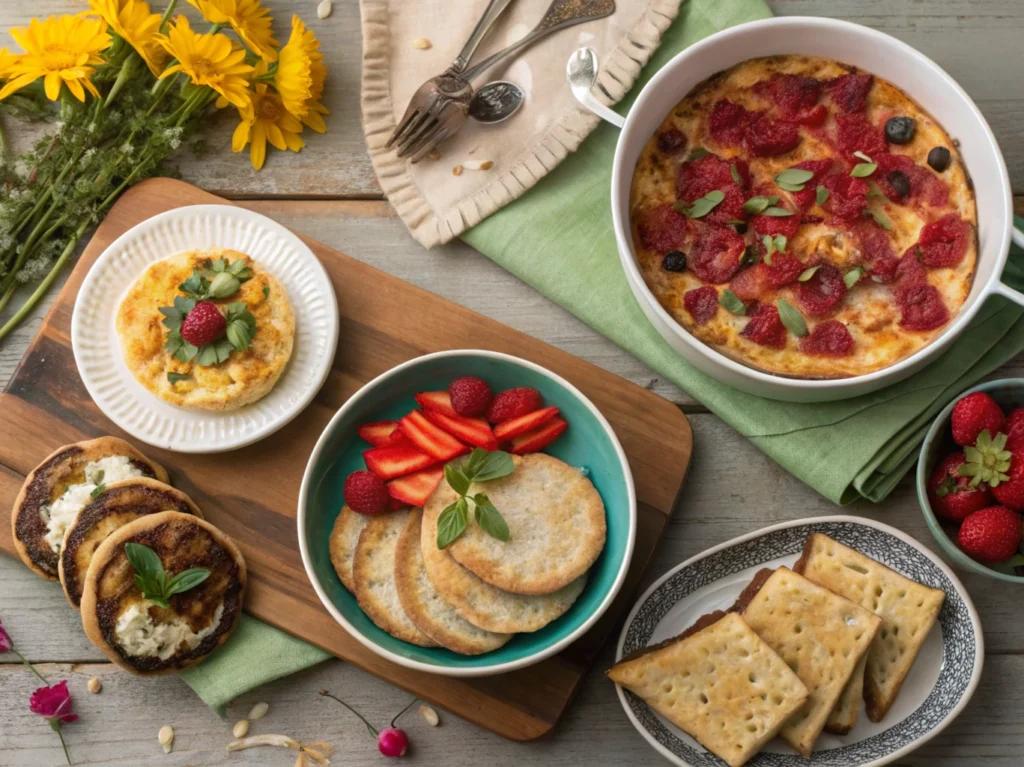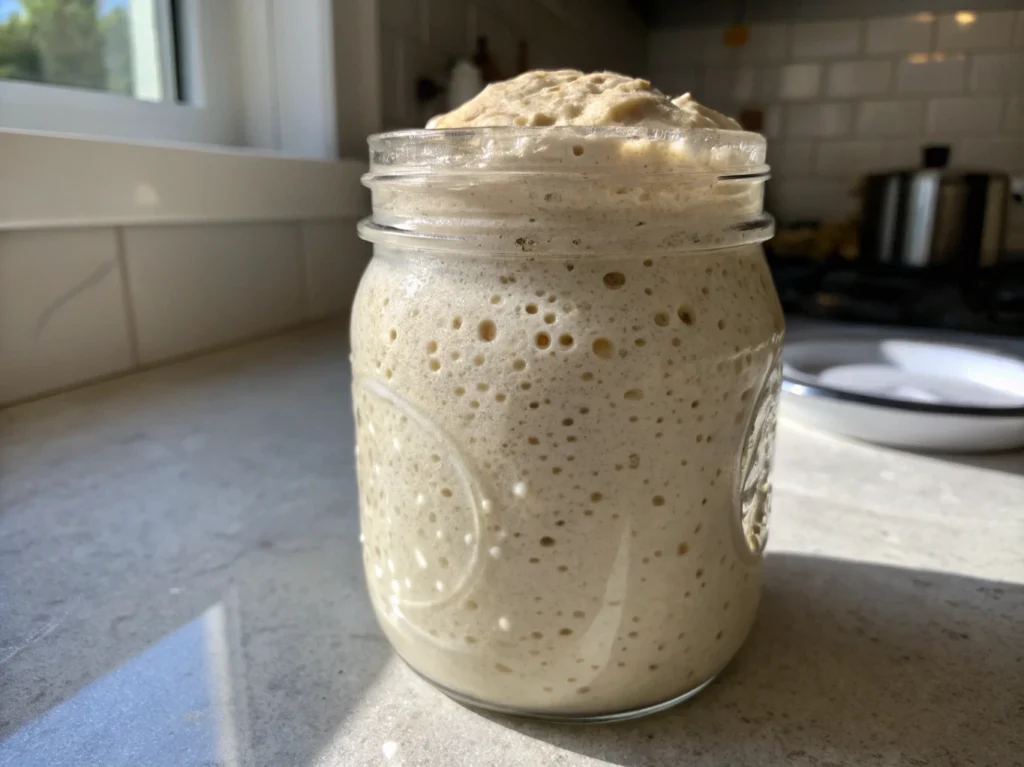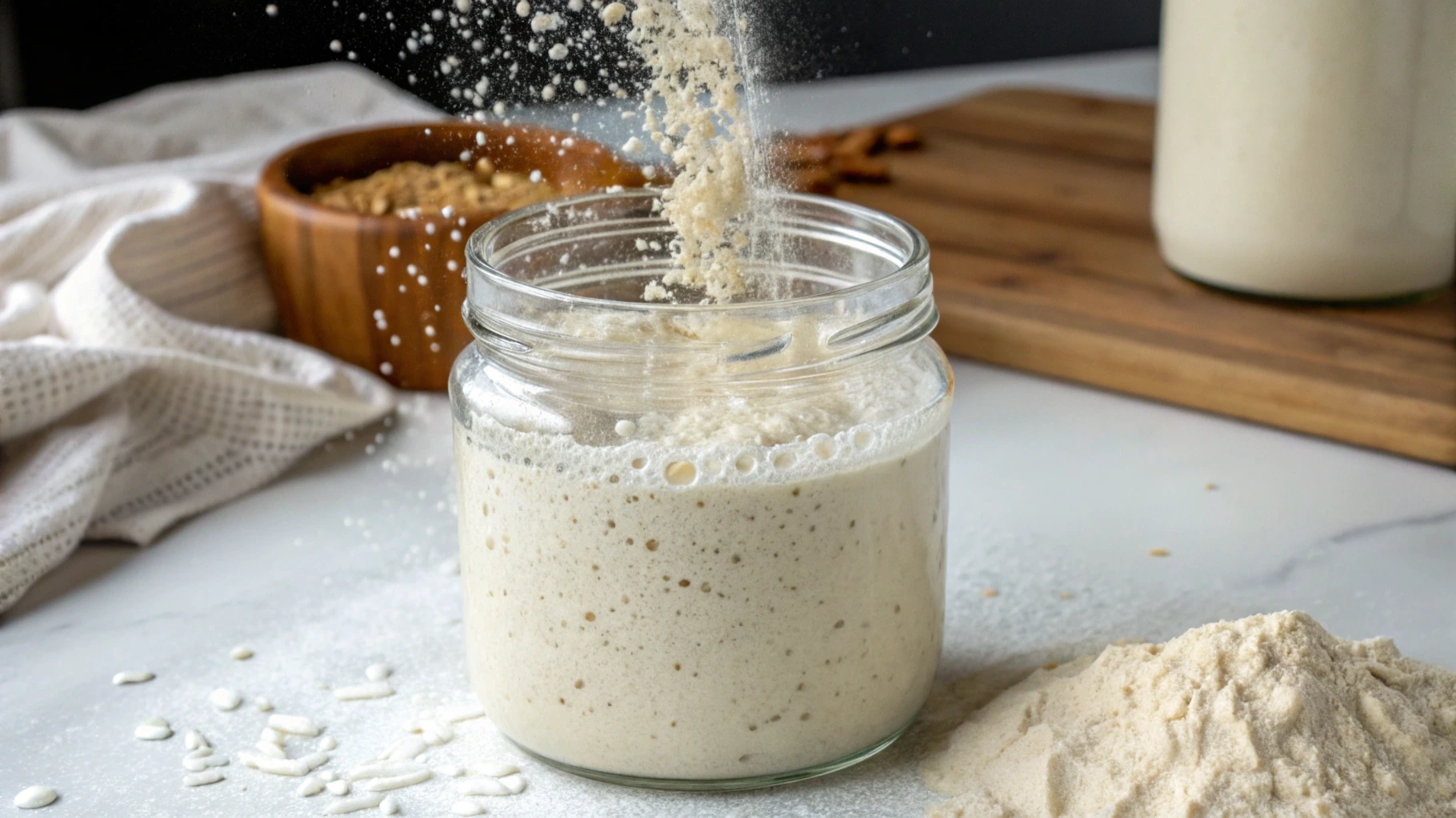Sourdough baking is an ancient and artful process that has captivated bakers worldwide. At its core lies the sourdough starter, a living culture of wild yeast and bacteria that gives sourdough bread its distinctive flavor and texture. However, to keep this culture healthy, you must occasionally discard part of it. Why? This article delves into the science, myths, and best practices behind discarding sourdough starter, along with tips on using the discard effectively.
The Basics of Sourdough Starter
What Is a Sourdough Starter?
A sourdough starter is a live mixture of flour and water teeming with wild yeast and lactic acid bacteria. These microorganisms work together to ferment the mixture, creating a bubbly, active culture that can leaven bread naturally. This ancient method of baking predates commercial yeast, relying instead on nature’s wild yeasts to do the job.
The starter is much more than a bread-making tool—it’s a miniature ecosystem. The wild yeast consumes sugars in the flour, producing carbon dioxide gas, which causes dough to rise. Meanwhile, the bacteria create the lactic and acetic acids that give sourdough its signature tang.
How Does a Sourdough Starter Work?
When you mix flour and water, enzymes in the flour break down starches into sugars. These sugars feed the wild yeast and bacteria, sparking fermentation. As the yeast ferments the sugars, it produces carbon dioxide, forming bubbles you see in a healthy starter.
But fermentation isn’t limitless. Over time, the starter consumes its food supply, and if left unattended, the microbes’ environment becomes overly acidic. Discarding and refreshing the starter with fresh flour and water ensure the microbes thrive in a balanced ecosystem.
Why Discarding Is Essential
The Science Behind Discarding

When managing a sourdough starter, discarding isn’t just about keeping the size manageable; it’s crucial for maintaining a balanced microbial ecosystem. A sourdough starter contains wild yeast and lactic acid bacteria that thrive when fed with fresh flour and water. However, if you skip discarding, the starter becomes overcrowded, and the microbes compete for limited resources.
This competition results in an overproduction of acids, which can make the starter overly sour and even kill off essential microbes. To keep your starter lively and active, you must discard a portion before feeding it. So, if you’ve ever wondered why must you discard sourdough starter, the answer lies in maintaining the delicate balance of this living culture.
Practical Reasons for Discarding
Discarding also has practical benefits. If you continuously feed your starter without discarding, it will grow exponentially. For instance, starting with just 50 grams of starter could balloon to hundreds of grams in just a few days, leading to wasted flour. Over time, this growth becomes unsustainable, especially if you’re feeding the starter twice daily.
Additionally, an oversized starter can be hard to manage. It takes up more space and can lead to inconsistencies in baking. By discarding regularly, you can control its size and ensure it stays in peak condition without breaking the bank on flour costs.
Myths About Discarding Sourdough Starter
“Discarding Is Wasteful” Myth
One common misconception is that discarding is wasteful. While it might seem counterintuitive to throw away part of your starter, it actually saves resources in the long run. Feeding a giant starter requires an excessive amount of flour. Discarding keeps the process efficient and sustainable.
Plus, the discard doesn’t have to go to waste. You can compost it, share it with friends, or use it in recipes like pancakes, crackers, and pizza dough. These creative uses show that discarding can be anything but wasteful.
“Discarding Isn’t Necessary” Myth
Some believe you can skip discarding entirely. However, neglecting to discard can lead to an overly acidic starter, which affects its ability to ferment properly. This imbalance can result in flat, dense bread with an unpleasant taste.
Discarding ensures your starter stays healthy and active. It’s a vital step for anyone serious about maintaining a reliable and flavorful sourdough culture. After all, why must you discard sourdough starter? To preserve its quality and your baking results!
Best Practices for Discarding
When and How to Discard
Discarding sourdough starter might feel like a daunting step, but it’s surprisingly straightforward once you establish a routine. The best time to discard is right before feeding. This process involves removing about half of the starter to make room for fresh flour and water.
The amount to discard depends on your baking schedule. If you bake often, you can keep a larger portion of the starter. If you bake less frequently, a smaller starter is more practical. A regular schedule, such as discarding and feeding once daily or every other day, ensures that your starter stays active and healthy.
For beginners asking, “Why must you discard sourdough starter?”, it’s all about maintaining balance. Without discarding, your starter can become overly acidic, diminishing its flavor and leavening power.
What to Do With Discard
Throwing away your sourdough discard isn’t your only option. Composting is an eco-friendly choice, or you can use the discard in recipes. Many bakers save discard in a sealed container in the fridge until they’re ready to use it in dishes like pancakes, crackers, or muffins.
For more creative uses of sourdough discard, check out recipes like Sourdough Dessert Recipes to turn your discard into something delicious and satisfying.
Using Sourdough Discard in Recipes
When to Use Discard in Recipes
Sourdough discard becomes more versatile as your starter matures. However, during the first week, it’s best to compost or throw away the discard, as the microbes are still stabilizing. Once your starter is well-established, the discard can enhance recipes with a subtle tangy flavor.
Recipes like crackers, pancakes, and quick breads are ideal for sourdough discard. These recipes don’t rely on the leavening power of an active starter, making discard a perfect fit.
Popular Discard Recipes

With sourdough discard, the possibilities are endless! Start your morning with fluffy discard pancakes, or whip up a batch of crispy crackers for an afternoon snack. Muffins, waffles, and even pizza dough can benefit from the unique flavor sourdough discard brings.
For more inspiration, explore options like Biggest Mistake with Sourdough Starter to avoid common pitfalls and get the most from your discard.
Long-Term Maintenance Without Discard
Options After Starter Maturity

Once your sourdough starter reaches maturity, discarding becomes less frequent and more strategic. Mature starters are stable and robust, allowing bakers to use the portion they remove in recipes instead of discarding it outright.
For example, if your recipe calls for 100 grams of starter, you can take that directly from the jar, leaving behind a small amount to refresh with flour and water. This approach means the discard is baked into your creations, reducing waste entirely.
However, for those who bake infrequently, refrigerating the starter can be a game-changer. By chilling the starter, you slow down its fermentation, minimizing the need for daily feeding and discarding.
Tips for Fridge Storage
When storing a starter in the fridge, always feed it first to ensure it has enough food to last. A ratio of one part starter to two parts each flour and water works well for cold storage.
Keep the jar loosely covered to allow gas to escape, and plan to feed the starter weekly. When it’s time to bake again, bring the starter to room temperature and refresh it twice before use.
Long-term maintenance without frequent discards is achievable with a mature starter, but beginners might still ask, “Why must you discard sourdough starter?”. The answer often lies in understanding how regular care fosters a thriving starter.
FAQs About Sourdough Starter and Discard
Why Must You Discard Sourdough Starter?
Discarding is crucial to maintain a manageable size and a balanced microbial environment. Without discarding, the starter becomes too acidic, which can harm its ability to ferment effectively.
How Much Starter Should I Discard?
The typical guideline is to remove about half of your starter before feeding. This ensures there’s enough room and food for the microbes to thrive.
What Happens If I Don’t Discard My Starter?
If you skip discarding, the starter will become too large to sustain and may develop an unpleasant smell or poor texture. This can lead to inconsistent baking results and wasted flour.
Can I Skip Discarding if I Bake Often?
Yes, frequent baking allows you to use the removed portion in recipes, eliminating the need to throw away the discard. Mature starters are particularly suited for this approach.
Sure! Let me provide a concise conclusion and wrap up the article with some closing thoughts.
Conclusion
Sourdough baking is more than just a culinary skill—it’s a harmonious blend of science and art. At the heart of this practice lies the sourdough starter, a living mixture that requires care and consistency to thrive. Understanding why must you discard sourdough starter is fundamental to mastering this age-old tradition.
Discarding may seem counterproductive at first glance, but it serves several crucial purposes. It helps manage the size of the starter, ensures a balanced microbial environment, and prevents the waste of valuable resources like flour. Without regular discarding, the starter can become too acidic, which negatively impacts its flavor and leavening ability. Additionally, the process of discarding allows bakers to introduce fresh flour and water, keeping the starter lively and active.
The Practical Side of Discarding
Discarding sourdough starter is not as wasteful as it might seem. In fact, it’s an essential step in keeping your baking process efficient. A starter that’s too large requires more flour to feed, which can quickly become impractical, especially for home bakers. By discarding, you can maintain a manageable portion of starter that is easier to care for and use.
Moreover, discard doesn’t have to go to waste. Bakers can use it in a variety of recipes, from pancakes and muffins to pizza dough and crackers. This versatility ensures that no part of the process feels excessive or unnecessary. For those who bake frequently, the discarded portion can be integrated into regular recipes, transforming what might have been wasted into a delicious treat.
Creative Uses for Sourdough Discard
For bakers who love experimenting in the kitchen, sourdough discard opens up a world of possibilities. Its unique tangy flavor can enhance both sweet and savory recipes. Imagine starting your morning with fluffy sourdough discard pancakes or ending your day with crispy crackers paired with cheese. The discard’s versatility ensures it never goes to waste.
To store discard for later use, keep it in an airtight container in the fridge. This method allows you to accumulate discard over several feedings and use it in bulk for larger recipes. Just remember to label the container with the date to keep track of freshness.
Building Confidence in Sourdough Baking
While the process of discarding and feeding might feel overwhelming at first, it soon becomes second nature. Following a consistent routine helps you develop confidence in maintaining a healthy starter. Whether you’re a seasoned baker or a beginner, understanding why must you discard sourdough starter empowers you to care for this living culture effectively.
Sourdough baking is a rewarding journey that combines tradition, creativity, and science. Each step, including discarding, plays a role in achieving beautifully textured, flavorful bread. With practice, you’ll not only master the process but also find joy in the art of sourdough baking.
For more tips and ideas, explore Sourdough Dessert Recipes for creative ways to use your starter. Would you like assistance crafting images or visual elements for the article? 😊

